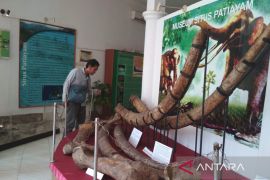Of 1,500 fossils belonging to Trinil Museum, only about 1,000 fossils have been examined and identified, the interpreter of Ngawi Trinil Museum, Catur Hari Gumono said here Friday.
"The rest is stored in a warehouse of Trinil Museum office. Some of the fossils are unharmed since been found. The latest fossils were found by villagers last May," Catur noted.
According to him the hundreds of fossils have not been researched due to the limited experts working in the museum.
Since it was established in 1991 the museum has no conservation expert or archaeologists who can research the fossils. During the time the experts have come from Heritage Preservation Center (BCB) Trowulan, Mojokerto district, East Java.
"If there is a new fossil found we invite the expert, but not always," Catur said.
Consequently the fossils consisting of ancient elephant, buffalo and others are just cleaned by the common officials who do not understand about conservation. Even the fossils are just put on the museum`s grounds.
In addition to the lack of expert the museum has no sufficient equipments to research the fossils such as computer that is used to digitally record the collections.
"All this time we work manually," Catur said.
He expected the center and the district administration would give support for the fossils preservation and research because the collection of Trinil Museum are the national as well as international archaeological and cultural assets.
"If the fossils are preserved and promoted well the Trinil Museum would be a high value historical attraction. Trinil not only belongs to Ngawi but also to the nation, even the world," Catur said.
In the Trinil site, a Dutch scientist Eugene Dubois in 1893 found the roof of the skull and thigh bones of Java man known as "Pithecantropus Erectus" meaning the creature walked upright and intelligent man. The discovery then was claimed to be the missing link. Such findings prove the Darwin`s theory that considers human ancestors were monkeys was wrong. The other fossils found in the sites were ancient animals and plants. (*)
Editor: Aditia Maruli Radja
Copyright © ANTARA 2012











